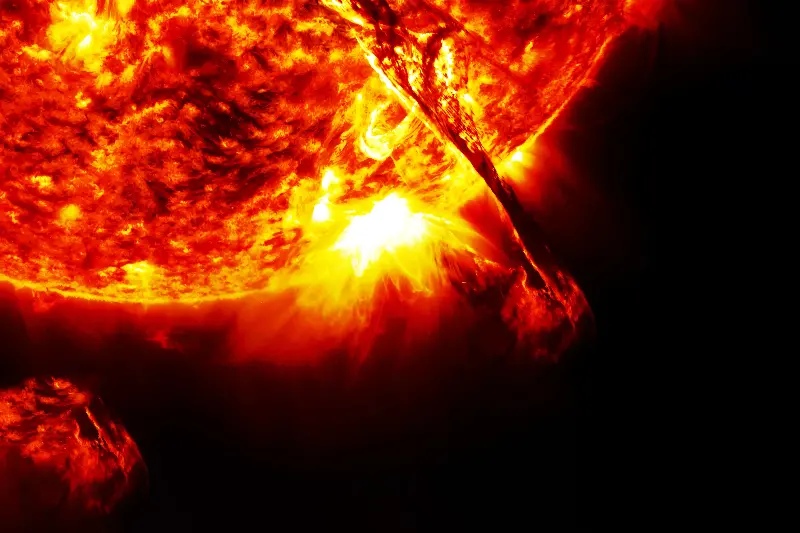For most of us, the sun is simply a bringer of daylight, warmth, and the occasional reason to reach for sunscreen. But hidden beneath its golden glow are cosmic tempests—solar storms—unleashing powerful forces that ripple throughout our solar system and right into our modern, tech-filled lives. While these solar tantrums can’t be seen with the naked eye, their effects are anything but invisible. Solar storms are the universe’s ultimate wild cards, serving up breathtaking beauty and chaotic disruption in equal measure.

What Exactly Is a Solar Storm?
Solar storms are the sun’s way of releasing pent-up energy. They come in the form of solar flares and coronal mass ejections (CMEs). Solar flares are sudden flashes of brightness, peppering space with bursts of radiation. Think of them as solar hiccups. CMEs, on the other hand, are the big hurrahs—massive bubbles of electrified gas hurled into space that can weigh as much as Mount Everest.
Both storms are driven by the sun’s magnetic field contorting and snapping, releasing energy equivalent to millions of nuclear bombs in seconds. Traveling at speeds up to several million kilometers per hour, these invisible storms can traverse the 150 million kilometers from the sun to Earth in just one to three days.
Historical Solar Superstorms and Their Surprising Impacts
You might think solar storms are the stuff of science fiction, but they’ve already made their mark on human history. The most famous event is the 1859 Carrington Event, a superstorm that lit up skies worldwide with auroras and set telegraph wires sparking—some operators even received electric shocks.
Fast forward to 1989, and the province of Quebec, Canada, plunged into darkness for nine hours as a solar-induced geomagnetic storm collapsed its power grid. Satellite operations faltered, radio signals wavered, and the northern lights danced as far south as Texas.
Even small storms today can disrupt GPS navigation, airline communications, and power supplies. In 2003, the so-called “Halloween Storms” forced flight reroutes, knocked out satellites, and caused transformer failures around the globe.

How Solar Storms Threaten Modern Technology
Our world is wrapped in an invisible network of delicate electronics, all susceptible to solar mayhem. When a CME reaches Earth, it can induce powerful electric currents in our atmosphere and, by extension, in power lines, pipelines, and undersea cables. These currents can overload and damage transformers, causing blackouts that can stretch for hours—or even weeks in severe cases.
Satellites in orbit are particularly vulnerable. High-energy particles from solar storms can short-circuit onboard electronics, skew GPS readings, and disrupt communication signals. Even astronauts in space are at increased risk, having to take shelter in shielded areas during intense storms.
The aviation industry keeps a close watch on solar weather too. High-frequency radio signals used for transpolar flights can get garbled or blocked, forcing costly detours and delays. With modern life so reliant on instant connectivity, even a moderate solar storm could ripple through everything from banking systems to emergency services.
The Sun’s Artistic Side: Auroras and Cosmic Light Shows
Solar storms aren’t all doom and gloom. When they reach Earth, their charged particles interact with our atmosphere to create one of nature’s most breathtaking spectacles—auroras. The aurora borealis (northern lights) and aurora australis (southern lights) are literal paintings in the sky, where colors dance and shimmer thanks to atmospheric gases colliding with solar particles.
During strong storms, these auroras are visible much farther from the poles than usual, drawing curious travelers to famously cold places just to witness their brilliance. Social media lights up whenever a big solar storm is forecast, with skywatchers from Scotland to Montana hoping for that mesmerizing green and purple glow.
Detecting and Defending Against Solar Storms
Luckily, we don’t have to tackle solar storms completely blind. Scientists at space agencies like NASA and NOAA keep constant watch on the sun using satellites such as the Solar and Heliospheric Observatory (SOHO) and the Solar Dynamics Observatory (SDO). These sentinels spot and measure flares and CMEs, allowing experts to alert power grids and satellite operators hours—or even days—ahead of stormy space weather.
Power companies have protocols to “island” parts of the grid, limiting damage during major geomagnetic storms. Some satellites can switch into safe mode, and airlines can preemptively reroute polar flights. Meanwhile, researchers work on creating more robust, storm-resistant technologies.
The Future of Living With the Sun’s Fury
The sun’s temper is a reminder of our position in a dynamic universe, where seemingly distant events can shape our daily lives. As we prepare for an ever more connected, electrified future, understanding and respecting these invisible storms is non-negotiable.
Solar storms are a cosmic reality check—but also a source of wonder. They power up stunning natural light shows and keep scientists on their toes, reminding us that even 93 million miles away, our nearest star can reach out and touch our world in ways both beautiful and profound. The next time you marvel at the sunrise, remember: there’s so much more to the sun than meets the eye.
